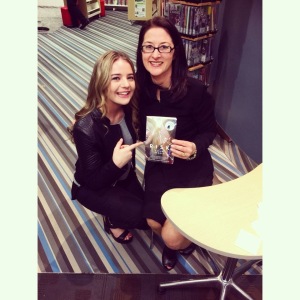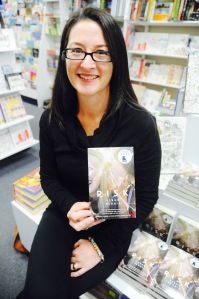A few weeks ago we reviewed Risk (Random House, 2015), a bold and compelling YA debut from Aussie author Fleur Ferris. Fleur was kind enough to take the time to chat with us about Risk and the writing process.
 First, congratulations on the publication of Risk, your debut Young Adult novel! Risk is about a girl, Taylor, whose best friend, Sierra, sneaks out on a date with a boy she meets online and doesn’t come home. Can you tell us where the idea for this story came from?
First, congratulations on the publication of Risk, your debut Young Adult novel! Risk is about a girl, Taylor, whose best friend, Sierra, sneaks out on a date with a boy she meets online and doesn’t come home. Can you tell us where the idea for this story came from?
A few incidents involving predators meeting and grooming girls online and then luring them away occurred in my surrounding towns. I’m a family friend to one of the girls and was shocked that she was almost a victim to this type of predator. This girl (then 14 years old) is smart and well-adjusted and doesn’t go looking for trouble. It frightened me that trouble found her. I started looking into cases and researching how predators use social media to find victims. I found out that anyone can use a proxy box to hide their identity, even from the police. During the process an idea for a book came to me.
In Risk Taylor and Sierra are groomed by an online predator, and one of the things the book does really well is to take a stand against victim blaming. Why did you feel that this was an important position to take?
It is an issue I have strong feelings about. In 1989 I watched a movie called The Accused, starring Jodie Foster, where a young woman is raped by a group of men in a bar. Back then, this movie sparked off much discussion about who was at fault and I remember feeling outraged by people saying Sarah Tobias (played by Foster) “asked for it” because of how she dressed and behaved. It is disappointing that twenty-six years later victims are still being questioned and blamed (or partially blamed) for violent crimes committed against them.
Jacob Jones, the man the girls meet on Mysterychat has some rather nasty tricks up his sleeve. What research did you do for Risk? Were there specific cases you looked at? And are there any sites like the Risk site Taylor starts in the book where young women can educate themselves about online predators and the methods they use?
I went into online chat rooms, like Mysterychat, and met and spoke with strangers. I experimented with false identities and posed as girls and boys as young as 10 and as old as 70. I set up my own proxy box identity and was amazed at how easy it was to do that. I spoke with as many people as possible, aged 10 and above, about what they do online. I spoke with police, teachers, parents, and adults who participate in online dating. I read about local and international cases involving online predators, and was horrified by how widespread this issue was.
There are many sites where people can educate themselves about online predators. Some recommended sites can be found on the Risk Teachers Resources on the Random House Website – http://www.randomhouse.com.au/content/teachers/risk.pdf

I really liked Taylor, your protagonist. She’s smart, level headed and compassionate, and Sierra’s abduction isn’t the first major challenge she’s had to deal with. How did you develop her character?
Taylor’s character was originally based on my niece, who was 15, the same age as Taylor, when I wrote Risk. I know my niece well, even some of her friends, and they are all smart, level-headed and compassionate. They are also very capable and have good relationships with their parents, teachers and other adults like Taylor does. Many teenagers I know are like Taylor.
Can you tell us a little bit about the writing process? How long were you working on Risk? How many drafts did the manuscript go through and did the story change much along the way?
Risk was written in 2013. The first draft took one month to write and I redrafted it once after some friends read it and gave feedback. I then sent it to my agent. After Random House decided to publish Risk, I did two structural edits and two copy edits with my editor. The story didn’t change at all. It’s just a better, tighter version.
What’s your routine for a typical writing day—do you have any little rituals that help get you into the creative headspace?
I don’t have any rituals. When I am writing the first draft of a novel I can write anywhere, anytime and it is on my mind day and night. This is the phase of writing that makes my heart sing and I become totally immersed in the story and characters. I don’t sleep much during the writing phase and I often start work at 4am and write for a few hours before the kids wake up and start getting ready for school. I try not to lose momentum and usually complete the first draft in a short space of time.
What appeals to you about writing YA?
Adolescence is a phase of life where you experience a lot of firsts. You are on the cusp of being an independent member of society. The transition between being treated as a child and treated as an adult is an exciting, but turbulent, time. The learning curve and challenges faced by teens in this time are huge. While they are finding who they are, who they want to be and what they want to do, life doesn’t slow down or wait for them. They have to keep up with school, deal with family issues and live to family expectations, and keep up with their peers. They also experience first love and sexual experiences, and are exposed to drugs and alcohol and driving motor vehicles. It’s a dangerous phase of life and I love to explore how people handle and cope with everything thrown at them.
Did you read a lot when you were at school? What were some of your favourite books growing up?
I have always been a reader, but it was never made a fuss of. When I was growing up I don’t know if I read more than anyone else as it was just what I did. I don’t ever remember discussing it, being praised for it, or it being acknowledged. My mum was, and still is, a huge reader and she would read books and then hand them on to me. Some of my favourite children’s books throughout my childhood years were The Magic Faraway Tree, James and the Giant Peach, the Flowers in the Attic series, Lord of the Flies and The Bell Jar.
What are some of your favourite recent Australian YA titles?
There are so many good Australian YA titles out right now. I loved Cooper Bartholomew is dead by Rebecca James, Ellie Marnie’s Every Series, Skye Melki-Wegner’s Chasing the Valley Series and The Hush. Nicole Hayes’ The whole of my world, The Pause by John Larkin…I could go on and on. For excellent Australian YA titles (and news) follow #LoveOzYA or @LoveOzYA on Facebook, Twitter and Instagram.
Are you working on a second manuscript, and can you share any details?
I have just signed a contract with Random House for my next YA novel. The title is unconfirmed at this stage, but I can say it is another contemporary stand-alone and sits well alongside Risk. It will be out mid next year.
What one piece of advice would you offer to the aspiring YA writers out there?
Keep writing, read widely, improve your craft (workshops/courses, have your work critiqued, critique the work of others, etc.) and help other writers do the same. Persevere.
A big thank you to Fleur for taking the time to chat with us! If you haven’t yet, take a look at our review of her novel Risk, and get yourself a copy!
Risk is available through Amazon (Kindle), Kobo and your local bookshop.

P.S.
Are you interested in writing YA? I’ve teamed up with Kill Your Darlings to produce ‘Introduction to Writing Young Adult Fiction’, an online writing workshop designed to equip aspiring YA writers with the skills and support to hone their craft and get to work.
Get the latest from Lectito delivered to your inbox.



